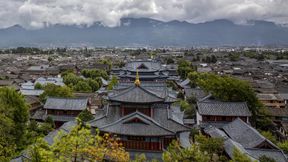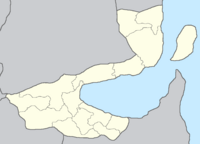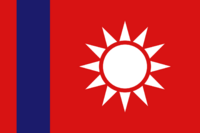Haimao
Haimao 海贸市 Hǎimào shì | |
|---|---|
City | |
Clockwise from top: Sanzhong skyline, San-Ta Temple, Yanyuan Lake | |
Map of Monsilva with Haimao highlighted | |
| Country | |
| State | |
| Settled | 10th century BCE |
| Declared city | 28 August 1470 |
| Leibo state est. | 1 July 1984 |
| Government | |
| • Body | Haimao County Council |
| • Governor | Zhong Daiyu (RNP) |
| Population (July 2022) | |
| • Total | 1,042,225 |
| Time zone | AMT+13 (Monsilvan Eastern Time, MET) |
| ISO 3166 code | MS-LEI-H |
| Major airports | Haimao Damien International Airport (LBD) |
| Transit System(s) | MRA Federal North Railway |
| Police[1] | Haimao County Police |
| Ambulance[2] | Leibo State Ambulance |
| Fire[3] | Leibo Fire Service |
Haimao (Monsilvan: 海贸市; pinyin: Hǎimào shì), is a city in Monsilva and the capital of the state of Leibo. It is located in the centre of the state, partially surrounded by the Gaobei Mountain Range which includes the famous Longsyue Mountain, or Dragon Snow Mountain. As the capital of Leibo, Haimao is the seat of the Leibo State Government, and is home to the Leibo State Office. The city has an estimated population of 1,042,225 (July 2022). Haimao is Monsilva's 12th most-populous city, which places it ahead of Yinjiang but behind Sanzhong. It is the largest county-administered city, which means that it is administered by a county council rather than a city council. Haimao holds 77% of the state of Leibo's population, with the other 23% living in the towns and villages located across the state.
Haimao is the coldest city in Monsilva, and is often given the name "雪市", meaning "Snow City". It has been inhabited for around 3000 years, which is much less than many of Monsilva's cities. This is due to Leibo's harsher geography, as during the winter the state's mountains are cold and covered in snow and ice, while in the summer, although not as cold, the rocky surfaces of the mountains are difficult to climb without modern equipment or the convenient highways which are now present all across the state. The city's industry has been focused around the cultivation of poppies and medicinal products. Originally these products were natural plants grown in the state which could survive its cold winters, however biomedical companies have also established themselves here despite being focused on technology rather than agriculture.
The city is a popular tourist attraction, with frequently visited locations including: the Old Town of Haimao, Yunyuan Lake, Longsyeue Mountain and the San-Ta Temple. Education in Haimao is good, with many educational institutions in the city. Haimao International University is a mega-multinational university which hosts hundreds of students who are able to study just under 50 different subjects in 8 different languages. It is partnered with the Academia Silvitica, an institution which focuses on educating people across Terraconserva about Monsilvan culture as well as being a general institution for education within Monsilva. Haimao is served by railways, highways, an airport and bus lines which allow travellers to enter and exit the city. The city itself is mostly connected through an extensive bus network and via the Federal North Railway, while the city is connected to the rest of Monsilva through the Monsilvan Railways Administration. Also serving the city is Haimao Damien International Airport, Monsilva's 8th busiest airport in 2022.
Contents
Toponymy
The name Haimao comes directly from the HY Pinyin of the Monsilvan "海贸", (Hǎimào). Individually, the character "海" (hǎi) means "sea" and the character "贸" (mào) means "trade", which means together "海贸" means "sea trade". This definition has confused etymologists for years, as Haimao is located nowhere near a sea, and due to its somewhat remote location, was not particularly well known for its trading routes. This has lead many to believe the name was misheard, especially due to the mistranslations caused between Luhainese and Standard Monsilvan throughout history.
The most logical and most common, although strange, is that a Luhainese speaker who had likely been asked to name Haimao to a Standard Monsilvan speaker and had said "還貓!" (Hái Māo!), which means "return the cat!", as the Luhainese speaker would not have understood the question. The reason behind the Luhainese speaker saying "return the cat!" is mostly unknown, however it was known that Haimao has had a noticeably large cat population as the wild cats they descended from originate from the mountains of Leibo. The Standard Monsilvan speaker, who would have simply believed that was the name, especially since many signs in the towns would have written "海贸" as "maritime trade" is what many townsfolk of Haimao called Luhai located around a hundred kilometres eastward, and the closest maritime port.
History
Early history and dynastic eras
Originally, the area around Haimao would have been inhabited by the descendants of Luhainese Monsilvan people, however the city wasn't established until the 10th century BCE, as permanent settlement in Leibo was difficult due to its geography. After 200 or so years of settlement, Haimao was engulfed within the newly established Qin dynasty. Under the Qin dynasty, Haimao was connected to the rest of the dynasty, including to the sea by paths maintained purely by foot traffic. This allowed the small city to begin growing economically and in population.
After surviving through four different dynasties, the city had grown into a respectable agriculture focused trading outpost. At the start of the 13th century with the unification of the Monsilvan Kingdoms, Haimao became even more remote from its rulers, with them being located several hundred kilometres away in Sanzhong. With this remoteness, the city essentially governed itself, with the Governor (巡抚) having far more authority over the happenings in the city and surrounding area than the Zhou dynasty government. This changed in 1414 however, the creation of the Beining Heavenly Kingdom, lead by Xiaojing Yuan, an extremely rich merchant who proclaimed himself king of Beining and the regions north of modern-day Maguan. The government of this kingdom was located in Luhai, which meant Haimao lost a lot of its autonomy.
Empire and Civil War period
When the Zhou dynasty ceded itself to the Empire of Baltanla in 1568, the Beining Heavenly Kingdom was quickly defeated by the Empire soon after. Although this meant the government moved far from Haimao once again, the Empire's administration was vast, and was able to situate loyal officials to the city to govern it to the Empire's ideals. During this period, Haimao became more connected to the rest of Monsilva and it began making a name for itself as the a large producer of poppies, which were mostly used to make opium a common pain reliever and drug for inducing sleep.
During the Monsilvan Civil War a century after the end of the Empire, Haimao was mostly untouched as it was too remote for either the Liberate Monsilva Movement or the Imperial Shan Armed Forces to bother claiming it. However, Haimao de facto existed under the jurisdiction of the LMM, as they would produce large quantities of medical products for soldiers who were fighting for the LMM.
Post-civil war and modern Monsilva
Haimao after the civil war was much the same as before, with medicinal agriculture being its main industry. However, with the coming of the mid-20th century, as recreational travel became more and more common, Haimao decided to utilise its colder climate and mountainous surroundings for travellers wishing to practice winter sports or simply relax in a mountainous setting. The developing tourism quickly took hold in Haimao and became one of its most important industries.
Even during martial law in Monsilva, during which many Monsilvans were unable to leave the country, the number of travellers visiting Haimao did not decrease. As air travel became more affordable to people, Haimao built Leibo's first and only commercial airport, Haimao Damien International Airport, which serves around 10 million people every year.
When the Monsilvan Republic was established in 1978, Haimao was a part of the region of Beining, which in 1983, became the state of Beining, with its own state government located in Luhai. One year later, in 1984, the state of Leibo was created, with Haimao established as its capital and home of the Leibo State Government.
Government
Local government
Haimao has its own county council, which administers the entire county of Haimao. The county consists of the city and its surrounding area which is mostly what is considered Haimao's greater metropolitan area. The county council is currently lead by the Reformed National Party.
State government
Haimao, as the capital of Leibo, is home to the Leibo State Government in the State Office. The Leibo State Parliament, also in the State Office, is a 29-seat unicameral legislature which serves the entire state of Leibo, including the city. The seats correspond to each municipality of the state, some of which are Haimao's urban municipalities.
Geography
Haimao is located in the valley of the Gaobei Mountain Range, which almost completely surrounds the city. It is also located on the Chun River which also flows through the cities of Tsingyi and Luhai. Its high altitude has made it one of, if not the coldest city in Monsilva. In the summer it reaches temperatures around 20-25 degrees celsius, while in the winter, the city itself reaches around 10 to 4 degrees celsius, but the mountains can reach temperatures as low as -8 degrees celsius at the height of winter.
Cityscape
Demography
As of 2022, there are over 1.0 million people living within Haimao's metropolitan area which makes it Monsilva's twelfth-largest city by population, ahead of Baoan but behind Sanzhong. Thanks to the Haimao International University, the city also hosts the most diverse student population and highest proportion of residents who can speak more than two languages.
Residents of Haimao are mostly non-religious, with the largest religious grouping being followers of Monsilvan folk religion. However there are also notable populations of Buddhists, Christians and Muslims.
Education
Haimao has many educational institutions around the city, from elementary schools to universities. Haimao International University is the only university in Monsilva that offers more than 10 courses in at least six different languages. It serves as an international destination for several universities across Terraconserva, and has a capacity of several hundred international students. Education in Haimao is mandatory up to the age of 16 aligning with both Leibo State Law and Monsilvan Federal Law.
Culture
Sport
Football is the most popular sport in Haimao, with Haimao City F.C. being one of Monsilva's best teams and has been in the Monsilvan Super League for many years. Major matches played by the team are often projected onto buildings and large screens in Haimao's City Square, where hundreds of people will go to watch the match. Football is a major part of Leibo culture, including Haimao. The most infamous incident involving football's fame in the city includes the 1996 Haimao City football riot whereby the loss of Haimao City F.C. to Tsingyi City F.C., their biggest rival, resulted in a riot taking place which eventuall lead to the death of one person and the injury of 37 others.
Tourism
Haimao is home to many tourist attractions which include:
- Old Town of Haimao
- Yunyuan Lake
- Longsyeue Mountain
- San-Ta Temple
- Haimao City Square
Travel
Haimao is the largest city without a metro or tram system, with most of its local public transport being run by busses and the Federal North Railway. As well as local services the FNR also operate services across Leibo, Luhai and Meixian. Other rail services are operated by the Monsilvan Railways Administration which runs services from Haimao to cities such as Tsingyi, Xinyuan and Menchi. As well as rail, the city is served by Haimao Damien International Airport which caters to around 10 million passengers in total every year, making it Monsilva's 8th busiest airport in 2022.
See also
| Rank | State | Pop. | Rank | State | Pop. | ||||
|---|---|---|---|---|---|---|---|---|---|
 Amking  Luhai |
1 | Amking | Amking | 10,855,226 | 11 | Sanzhong | Weishi | 1,116,871 |  San Kong  Menchi |
| 2 | Luhai | Luhai | 5,050,800 | 12 | Haimao | Leibo | 1,042,225 | ||
| 3 | San Kong | Shaoyu | 4,066,512 | 13 | Yinjiang | Shaoyu | 984,717 | ||
| 4 | Menchi | Meixian | 3,973,229 | 14 | Huiyong | Shaoyu | 826,314 | ||
| 5 | Maojie | Maguan | 3,461,317 | 15 | Tsingyi | Luhai | 800,179 | ||
| 6 | Shangrao | Donguan | 2,953,057 | 16 | Baoan | Zaixian | 795,974 | ||
| 7 | Zhangye | Xiaogu | 2,585,883 | 17 | Taimali | Xishanjia | 776,469 | ||
| 8 | Wodai | Wuzhong | 2,245,521 | 18 | Dali | Wuzhong | 596,911 | ||
| 9 | Chishang | Huachang | 1,674,966 | 19 | Menggu | Bazhong | 584,320 | ||
| 10 | Waiping | Bazhong | 1,445,989 | 20 | Taoyuan | Meixian | 558,627 | ||






